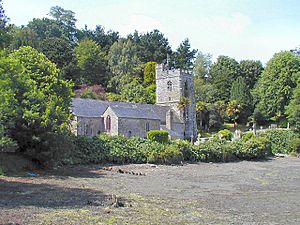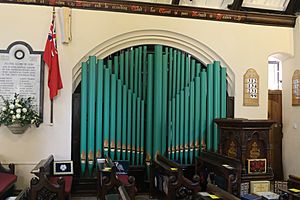St Just's Church, St Just in Roseland facts for kids
Quick facts for kids St Just's Church, St Just in Roseland |
|
|---|---|

St Just's Church, St Just in Roseland
|
|
| 50°10′55.74″N 5°00′56.47″W / 50.1821500°N 5.0156861°W | |
| Location | St Just in Roseland |
| Country | England |
| Denomination | Church of England |
| History | |
| Dedication | St Justinian of Ramsey Island |
| Consecrated | 1216 |
| Administration | |
| Parish | St Just in Roseland |
| Deanery | Powder |
| Archdeaconry | Cornwall |
| Diocese | Diocese of Truro |
| Province | Province of Canterbury |
St Just's Church, St Just in Roseland is a beautiful old church located in St Just in Roseland, Cornwall, England. It is a Grade I listed building, which means it is very important and protected because of its history and special architecture. The church belongs to the Church of England and is part of the Diocese of Truro.
Contents
History of St Just's Church
Early Beginnings
The church is thought to have started around the year 550 AD. It was built to honor a saint called St Just the Martyr. For about 400 years, Celtic priests from a nearby religious community called Lanzeague looked after the church.
Around 950 AD, the church became part of the larger Christian church system. It was taken over by the Bishops of Cornwall, Crediton, and Exeter.
Changes Over Time
In 1140, Robert Warelwast, who was the Bishop of Exeter, gave the church to the Canons of Plympton Priory. Canons are like priests who live in a religious community. They sent their own vicars to serve the church.
However, in 1189, a local lord named John le Sor got the church back. From that time on, the church has been led by Rectors. A Rector is the main priest in charge of a parish.
Building the Current Church
The church building you see today was mostly built in the 13th century. It was officially opened and blessed in 1216 by Simon of Apulia, who was also a Bishop of Exeter. This blessing is called a "consecration."
Restoration Work
Many years later, in 1872, the church was carefully repaired and updated. This is called a "restoration." The Bishop re-opened the church on Monday, November 18, 1872. He even arrived at the church on a ship called HMS Ganges!
During this restoration, new wooden benches (pews) were added. A new pulpit, where the priest gives sermons, and a reredos, a decorated screen behind the altar, were also put in. The floor was paved with special patterned tiles. The altar, which is a table used for religious services, was raised on two granite steps. Local craftspeople did all the woodwork and stone carving.
A small room called a vestry was added to the church in the 20th century. This room is often used by the clergy to prepare for services.
Parish Status
St Just's Church is part of a "joint parish." This means it shares its clergy and some activities with another church.
- The other church in this joint parish is St Mawes' Church, St Mawes.
The Church Organ
The church has a beautiful organ, which is a large musical instrument often found in churches. This organ was not always in St Just's Church. It first belonged to St John the Evangelist's Church in Treslothan.
In 1966, the organ was moved to St Just's Church by a company called Hele & Co. It has been updated since then by Lance Foy. You can find detailed information about this organ on the National Pipe Organ Register.
Virtual Pipe Organ App
In 2018, something really cool happened! The sound of the church organ was made into a "Virtual Pipe Organ" app. This app lets people play the organ's sounds on their iPhone or iPad. Half of the money made from this app is given to the church to help pay for the organ's upkeep.
Notable People Connected to the Church
The churchyard of St Just's Church is a burial ground. One notable person buried here is Charles Bowen Cooke. He was a very important engineer who designed and built locomotives (train engines). His grave is marked by a cross in the churchyard.
Images for kids





